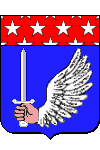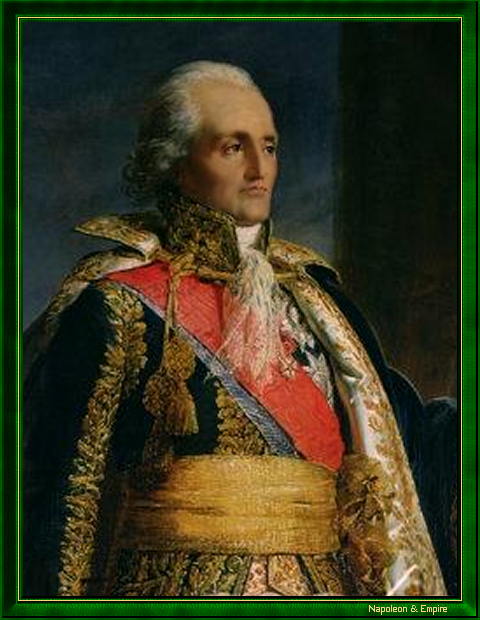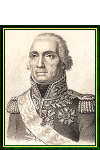Duke of Conegliano
Pronunciation:

Born on July 31, 1754 in Moncey (parish of Palise), Franche-Comté, eastern France, to a lawyer at the Besançon parliament, Bon Adrien Jannot de Moncey was an unruly and undisciplined child from an early age. At the age of fifteen, he ran away from school and joined the army; his father ransomed him; he did it again. This time, he left the service of his own free will a few months later, before joining the gendarmerie again in 1774. When he reached the rank of lieutenant in 1785, he saw his career blocked, like so many others, by his non-noble origins.
In 1789, he bought the château of his native village from the Marquis du Cheylard.
In 1791, Moncey enlisted again, this time in a volunteer regiment, which elected him captain. He was assigned to the army of the Pyrénées-Occidentales from 1793 to 1795. He was so well appreciated by the representatives on mission that they appointed him brigadier general on April 18, 1794, and major general and commander-in-chief of the army six months later.
After having tried to escape this responsibility, which he considered overwhelming - but his letter to the Comité de Salut Public had no effect - he resigned himself to assuming it, and did so with great success. A series of victories enabled him to push the Spanish back behind the Ebro and take Bilbao on July 17, 1795.
Denounced as a royalist after the coup d'état of 18 fructidor Year V, and a friend of Lazare Carnot and Jean-Charles Pichegru, he was discharged despite an eloquent memoir in support of his case (October 26, 1797). Unemployed for the next two years, he was reinstated two months before the 18 Brumaire, and lent his support to Napoleon Bonaparte.
He led a corps in the second Italian campaign, in 1800, but got on badly with Guillaume Marie-Anne Brune and then Joachim Murat, under whose orders he refused to serve.
On December 3, 1801, Bon Adrien Jannot de Moncey was appointed Inspector General of the Gendarmerie, making him the equal of the Minister of Police. In this capacity, he had his own espionage services, secret funds for which he was accountable only to the First Consul Napoleon Bonaparte, and direct access to the latter, without even going through the Secretary of State, all in an era particularly rich in conspiracies.
Marshal in 1804, Grand Eagle of the Legion of Honor in 1805, he was sent to Spain at the beginning of 1808, where he won a number of victories that earned him the title of Duke of Conegliano on July 2, led the siege of Valencia (September) and began the second siege of Saragossa in December.
He returned to France in 1809 and commanded various reserve armies until 1813.
On March 30, 1814, as second-in-command of the Paris National Guard, he heroically defended the Barrière de Clichy against the Russians , then, after the capitulation, gathered the remnants of his troops and led them back to Fontainebleau.
Peer of France under the first Restoration, Peer of France under the Hundred Days, he lost this title when Louis XVIII returned for the second time.
Appointed to preside over the council of war charged with judging Marshal Michel Ney, he sent the king a magnificent letter of refusal: Sire, faced with the cruel alternative of disobeying Your Majesty or failing my conscience, I had to explain myself to Your Majesty. I will not enter into the question of whether Marshal Ney is innocent or guilty... It was at the passage of the Beresina, Sire, it was in that terrible catastrophe that Ney saved the wreckage of the army; and I would send to his death the man to whom so many Frenchmen owe their lives!... No, Sire, if I am not allowed to save my country, nor my own existence, I will at least save honor (...).
As a result of this letter, he was stripped of all his ranks and sentenced to a three months imprisonment in the fortress of Ham. The Prussian commandant of the fortress having declined the shameful honor of being the jailer of France's glories, Moncey settled for the duration of his sentence in the inn opposite the prison. It is said that the Prussian regimental band serenaded him there every day. He then retired to his château de Baillon, near Luzarches, pretending to consider himself a prisoner. On July 3, 1816, the king, feeling ridiculous, discreetly gave him back his baton. The peerage followed in 1819.
In 1823, at the age of 70, the Duke of Conegliano again took command of an army corps during the Spanish Expedition. At its head, he conquered Catalonia, taking Barcelona, Tarragona and Hostalrich.
In 1833, following the death of Jean-Baptiste Jourdan, he became Governor of Les Invalides , where he received Napoleon's ashes on December 15, 1840. After kissing the hilt of Napoleon's sword, this old man of eighty-seven, who had been begging his doctors for days to let him live long enough to receive the Emperor, said the words that marked the end of an era: Now, let's go home and die
.
He died on April 20, 1842, and was buried at Les Invalides, in the governors' crypt of Saint-Louis cathedral .
"Marshal Moncey, Duke of Conegliano" by Jacques Luc Barbier-Walbonne (Nîmes 1769 - Passy 1860).

Model of all virtues, according to Jean-de-Dieu Soult, the Duke of Conegliano is only mentioned once in the Memorial of Saint Helena:
Moncey was an honest man. Freemasonry: In 1814, Marshal Moncey became Grand Officer of Honor of the Grand Orient of France.
In 1976, the French Postal Service issued a 0.80 F stamp bearing the effigy of Bon Adrien Jannot de Moncey .
Moncey's name is inscribed on the 33rd column (west pillar) of the Arc de Triomphe de l'Étoile , while a full-length statue by Félix Desruelles honors his memory on the north façade of the Louvre, rue de Rivoli , and a monument surmounted by a bronze statue , the work of Amédée Doublemard, has commemorated his heroic conduct on March 30, 1814, on Place de Clichy since 1869.
Detailed military career
established by Mr. Eric Le Maître, put online with his kind permission.Wounded in action
None.Captivity
None.First engagement
Volunteered in the Champagne Infantry Regiment on September 15, 1769.Career development
Second lieutenant, August 16, 1779.Second Lieutenant, August 30, 1782.
First Lieutenant, July 1, 1785.
Captain, April 1, 1791.
Battalion Chief, June 26, 1793.
Brigadier General, February 18, 1794.
Major General, June 9, 1794.
Marshal of the Empire, May 19, 1804.
Service record
Volunteered in the Champagne Infantry Regiment on September 15, 1769.Acquired leave of absence, June 30, 1773.
Joined the company of English gendarmes, April 8, 1774.
Left on August 15, 1776.
Nassau-Siegen infantry corps, August 16, 1779.
5th battalion of chasseurs, June 1, 1788.
In the army of the Pyrénées-Occidentales, from 1793 to 1795.
With the 5th light demi-brigade, June 26, 1793.
Provisional General-in-Chief of the army, August 9, 1794, confirmed August 17, 1794.
Commander of the 11th military division at Bayonne, September 15, 1795.
Discharged as a royalist on October 26, 1797.
Reinstated on September 20, 1799.
Commanded the 12th military division, November 30, 1799.
Commander of the 19th military division in Lyon, December 3, 1799.
Lieutenant to the General-in-Chief of the Army of the Rhine, March 24, 1800.
Commanded a corps of 15,000 men in Helvetia, April 16, 1800.
Joined the reserve army, May 9, 1800.
In charge of defending Lombardy, June 9, 1800.
Commanded a corps in the Army of Italy, responsible for occupying Valtellina, June 20, 1800.
Commanded the left wing of the Army of Italy, July 5, 1800.
Acting commander of the Army of Italy in place of Brune, from March 8 to June 19, 1801.
Lieutenant-General commanding French troops in Cisalpine, June 2, 1801.
First Inspector General of the Gendarmerie, December 3, 1801.
Commander-in-chief of the Ocean Coast Observation Corps, December 16, 1807.
Led the same corps to Spain, January 9, 1808.
Commander of the 3rd corps of the Spanish army, September 7, 1808.
Commander-in-chief of the Tête-de-Flandre in Belgium, September 5, 1809.
Commander of the reserve of 3 National Guard divisions in Belgium, in place of Bessières, September 11, 1809.
Inspector of National Guard cohorts in the 12th, 13th, 14th and 15th military divisions, 1812.
Commander-in-chief of the Pyrenees reserve army, November 16, 1813.
Major General of the Paris National Guard, January 8, 1814.
Took part in the defense of Paris, March 30, 1814.
Peer of France during the First Restoration, June 4, 1814.
Peer of France during the Hundred Days, June 2, 1815.
Removed from office for refusing to preside over the council of war charged with judging Marshal Ney, and sentenced to three months' imprisonment, August 29, 1815.
Reinstated in the enjoyment of his salary as of December 1, 1815, by royal decision of July 3, 1816.
Reappointed Pair de France, March 5, 1819.
Governor of the 9th Military Division, from April 5, 1820 to November 5, 1830.
Commander-in-chief of the 4th Corps of the Pyrenees Army, February 12, 1823.
Governor of the Hôtel Royal des Invalides, December 17, 1833.
Address
73, Rue du Faubourg Saint-Honoré. Paris VIIIème arrondissement
The Imperial almanach of 1811 indicates that Marshal Moncey lived at this addrss.Château de Moncey. Department of Doubs
The Duke of Conegliano has also owned this manor house in his native village since 1789.Acknowledgments
We express our gratitude to Major General Christian Baptiste, Director of the Army Museum, who granted us access to the Governors' Vault of the Saint-Louis des Invalides Cathedral, and to Mr. Mickaël Blasselle, who guided us for this visit in December 2011.The photo of the full-length statue of the Duke of Conegliano, rue de Rivoli in Paris, was kindly provided to us by Mr. Cyril Maillet.
Other portraits

Enlarge
"Captain Bon-Adrien Jannot de Moncey in 1792" by Pierre Joseph Dedreux-Dorcy (Paris 1789 - Bellevue 1874).

Enlarge
"Marshal Moncey, Duke of Conegliano". Engraving by Adolphe Forestier (Paris 1801 - Paris 1885).